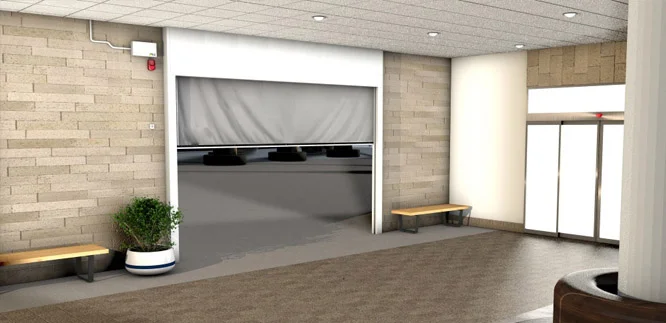Modern building safety has taken a step further from fire extinguishers and fire alarms.
Fire curtains are now being adopted by businesses and homeowners to make their properties safer from fire. They don’t look out of place in your contemporary property designs.
Fire curtains are fire-resistant barriers. They are hidden in the headbox until it’s time for them to spring into action. That happens when a fire alarm or detector triggers them. They automatically come down between guide channels.
We explain their importance, types, applications, and benefits.
Types
- Horizontal Fire Curtains: The horizontal deployment of these curtains separates floors or levels within a building. Malls and atriums usually use them to keep smoke from rising to higher levels.
- Vertical Fire Curtains: These curtains can be put up vertically and can be used to block off openings like hallways, stairwells, and escalators. In both business and residential buildings, they are used to divide spaces and keep escape routes safe.
- Perimeter Fire Curtains: In case of a fire, these curtains separate certain areas from the rest of the building by forming a perimeter barrier around them.
- Insulated Fire Curtains: The extra insulation in these curtains makes them better at keeping heat out. This makes it safe for people to walk by the curtain during the evacuation.
Applications
- Commercial buildings
- Residential buildings
- Healthcare facilities
- Educational institutions
- Transportation hubs
- Industrial facilities
Benefits
- Fire curtains divide a building into sections that stop fire and smoke from spreading and protect exits.
- Unlike regular fire-rated doors or walls, fire curtains let architects make designs that are more open and flexible, making spaces bigger and clearer.
- When they are folded up, fire curtains are small and unobtrusive, and they do not take up much space. This makes them perfect for places where space is limited.
- In large open spaces where traditional fire safety methods might not work or are more expensive, fire curtains may be a more cost-effective option.
- When they are not in use, fire curtains can be made to look like they belong with the general design theme inside the building.
Installation and Maintenance
For fire curtains to work, they must be installed and maintained correctly.
Expert installation that follows the manufacturer’s instructions and local building codes is necessary.
You need timely inspections and testing to identify and address issues like:
- obstructions
- damage
- malfunctions
Manufacturers and suppliers you can trust often offer maintenance packages that include repairs, replacements, and regular checks.
Regulatory Compliance
For the USA – standards like NFPA 80 and UL 10D have to be complied with.
For the UK– the British Standard BS 8524 needs to be followed.
Owners and managers of buildings must follow these standards to stay in line with the law and keep people safe.
Parting Thoughts
These days, fire curtains are a big part of fire safety plans because they can be used in many situations and are good at keeping fires under control and protecting people and property.
To get the most out of fire curtain systems, they need to be:
- installed correctly
- maintained regularly
- used in accordance with the rules
Building owners and managers can make their properties safer from fire by working with reputable manufacturers and suppliers and following the maintenance schedules given.
As the demand for open and flexible building designs rises, fire curtains will become more important for keeping buildings safe.
The A1S Group has been making and installing fire curtains, smoke curtains, fire shutters, and roller shutters for more than 33 years. They are known for meeting strict safety standards and coming up with new, aesthetically pleasing ways to keep commercial, residential, and industrial buildings safe from fire.



